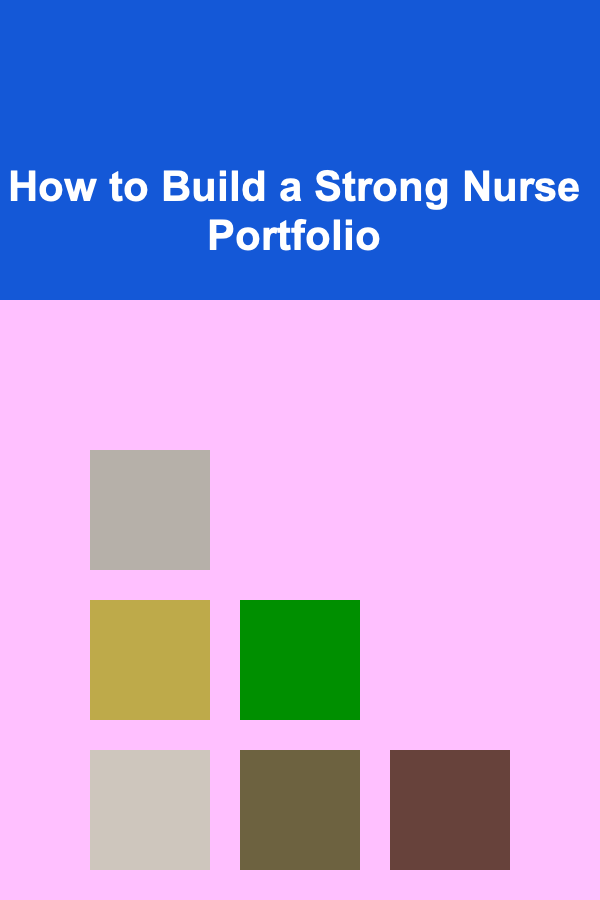
How to Build a Strong Nurse Portfolio
ebook include PDF & Audio bundle (Micro Guide)
$12.99$5.99
Limited Time Offer! Order within the next:

A well-crafted portfolio is one of the most powerful tools a nurse can have to showcase their skills, experiences, and professional development. A nurse portfolio not only serves as a comprehensive record of your accomplishments but also demonstrates your commitment to patient care, your ability to stay current with medical advancements, and your professional growth. Whether you're a newly graduated nurse looking to break into the workforce, an experienced nurse seeking a promotion, or someone exploring opportunities in different healthcare settings, a strong portfolio can set you apart from other candidates and help you achieve your professional goals.
This article outlines the essential steps to build a strong nurse portfolio that highlights your expertise, achievements, and potential for future growth. By taking the time to create a thoughtful and thorough portfolio, you'll not only have a valuable tool for job applications but also a reflective resource for personal development.
Start With a Strong Foundation: Understanding the Purpose of Your Portfolio
Before diving into the details of creating a nurse portfolio, it's important to understand its purpose. A nurse portfolio serves multiple functions throughout your career:
- Professional Representation: It provides a clear representation of your skills, experiences, and accomplishments as a nurse.
- Career Advancement: It can be used as a tool for job applications, performance evaluations, and interviews to highlight your qualifications.
- Reflective Practice: It can be a place to reflect on your professional growth and identify areas for improvement or new areas of interest within the nursing field.
- Continuing Education: It helps you keep track of continuing education, certifications, and training that enhance your knowledge and skills.
A nurse portfolio is a living document, one that should grow and evolve as you gain new experiences, certifications, and reflect on your personal and professional journey.
Organize Your Portfolio: Key Sections to Include
A strong nurse portfolio should be well-organized and easy to navigate. Depending on your specific career path and experiences, you can tailor your portfolio to best highlight your strengths. Below are the key sections that should be included in a comprehensive nurse portfolio.
A. Personal Information
The first section of your portfolio should provide a clear and concise introduction to who you are as a nurse. This section should include:
- Full Name: Your professional name, and if applicable, your credentials (e.g., RN, BSN, MSN, NP).
- Contact Information: Your phone number, email address, and professional social media profiles (such as LinkedIn).
- Professional Summary: A brief summary of your career, highlighting your areas of expertise, specialties, and professional values. This should be a snapshot of who you are as a nurse and what you bring to the field.
B. Resume or Curriculum Vitae (CV)
While your resume is a standalone document, it's important to include it in your portfolio as well. This section should outline your education, work experience, certifications, professional achievements, and relevant skills. Be sure to:
- Highlight your key accomplishments: Instead of just listing job duties, focus on the achievements that reflect your contributions to patient care, team collaboration, and overall outcomes.
- Update regularly: Ensure that your resume or CV reflects the most current job experiences, skills, and certifications.
C. Education and Certifications
This section should provide detailed information about your educational background and professional development. Include:
- Nursing Degrees: List the degrees you have obtained (e.g., Associate's Degree in Nursing, Bachelor of Science in Nursing, Master's, or Doctorate). Be sure to note the school and year of graduation.
- Certifications: Include any additional certifications you have earned, such as Basic Life Support (BLS), Advanced Cardiovascular Life Support (ACLS), Pediatric Advanced Life Support (PALS), or specialty certifications like critical care, oncology, or pediatrics.
- Continuing Education: Highlight any continuing education courses, workshops, or conferences you have attended. This shows your commitment to staying up-to-date with the latest trends in healthcare.
D. Professional Development and Training
This section is where you can highlight any ongoing training, seminars, or professional development programs you've participated in. It demonstrates your commitment to continuous learning. Include:
- Leadership and Management Training: If you've taken courses in leadership or management, be sure to mention them, as they demonstrate your readiness for advancement into supervisory roles.
- Clinical Training: Highlight any additional clinical training or certifications, especially those relevant to your nursing specialty.
E. Performance Reviews and Evaluations
Performance evaluations are an essential part of any nurse's portfolio. Including positive feedback and performance reviews can help demonstrate your professionalism and effectiveness in patient care. Be sure to include:
- Annual Performance Reviews: If available, include copies of your annual or bi-annual performance reviews.
- Supervisor Recommendations: Letters of recommendation or positive comments from supervisors or colleagues can provide valuable insights into your work ethic and competence.
- Peer Evaluations: Feedback from coworkers or peers can also strengthen your portfolio, showing that you are a collaborative and respected member of the healthcare team.
F. Clinical Skills and Competencies
In this section, you should provide evidence of your clinical skills and competencies, including specific procedures you are proficient in. This may include:
- Patient Care Skills: Specific examples of your nursing skills, including patient assessment, administering medications, wound care, and others.
- Technology Proficiency: Familiarity with electronic health records (EHR), hospital management systems, or any other healthcare technology relevant to your specialty.
- Specific Procedures: Highlight any specialized skills, such as inserting IVs, performing catheterizations, or any other clinical procedures you are trained to perform.
G. Achievements and Accomplishments
This section should be used to showcase your most significant achievements, such as:
- Awards and Recognitions: If you've received any nursing awards, recognitions, or have been acknowledged for excellence in patient care, include this in your portfolio.
- Research or Publications: If you have been involved in any research projects or have had work published in nursing journals, include it here.
- Volunteer Work: Any volunteer experiences, whether they involve nursing or other roles, can reflect your commitment to service and community care.
H. Reflection and Self-Assessment
A reflective section is an excellent way to show personal growth and self-awareness. In this section, include:
- Reflective Journals: Consider adding reflections on significant experiences or challenges you've faced as a nurse. These reflections demonstrate self-awareness and your ability to learn from your experiences.
- Goals for the Future: Setting short- and long-term goals for your career shows that you are proactive about your professional development and aspire to grow within the field.
Make Your Portfolio Visually Appealing
The visual appeal of your portfolio matters. While the content is essential, it's important that your portfolio is well-organized, easy to navigate, and professional-looking. Consider the following:
- Consistent Formatting: Use consistent fonts, spacing, and headers to make your portfolio easy to read. A clean, professional layout ensures that potential employers or colleagues can quickly find the information they need.
- Digital Portfolio: Many nurses are opting to create digital portfolios that can be shared with potential employers through email or online platforms. Tools like LinkedIn, Canva, or Adobe Spark offer templates that can help you create a polished, visually appealing portfolio.
- Keep it Simple: Don't overwhelm the viewer with excessive text or clutter. Keep your portfolio focused on the most important information and use bullet points or short paragraphs to enhance readability.
Tailor Your Portfolio to Your Career Goals
Your nurse portfolio should be adaptable depending on your career goals. Whether you're applying for a job in a different specialty, aiming for a managerial position, or looking to transition into academia, you should tailor your portfolio to highlight the skills and experiences that align with your aspirations.
- For Job Applications: Emphasize your clinical skills, certifications, and any accomplishments related to the specific job you're applying for.
- For Career Advancement: If you're aiming for leadership roles, focus on your leadership training, experience in managing teams, and any managerial certifications you've obtained.
- For Academic Pursuits: If you're considering transitioning into teaching or research, highlight your research projects, publications, and any relevant teaching experience.
By customizing your portfolio, you ensure that it aligns with your current and future career goals.
Maintain and Update Your Portfolio Regularly
Building a nurse portfolio is not a one-time task; it should be an ongoing project that you update regularly. As you gain new certifications, attend training sessions, or achieve new accomplishments, be sure to add them to your portfolio.
- Set a reminder to update it: Schedule time at least once every six months to review and update your portfolio. This ensures it remains current and relevant.
- Add new feedback: Keep adding positive performance reviews, feedback from colleagues, or any additional accomplishments that may arise.
By maintaining an up-to-date portfolio, you'll always be ready to seize new opportunities as they arise in your nursing career.
Conclusion
Building a strong nurse portfolio is an essential step in showcasing your skills, accomplishments, and professional development. A well-organized and reflective portfolio can serve as a powerful tool for career advancement, job applications, and personal growth. By including the right sections, making your portfolio visually appealing, and tailoring it to your career goals, you will have a valuable resource that reflects who you are as a nurse and demonstrates your commitment to the profession.
Remember that your portfolio is not just a tool for securing a job; it's a reflection of your journey as a nurse and your dedication to continuous improvement in patient care and professional development. Start building your portfolio today, and let it evolve with your career.
Reading More From Our Other Websites
- [Organization Tip 101] How to Share Your Wellness Space Organization Tips Online
- [Personal Care Tips 101] How to Select Teeth Whitening Strips Based on Ingredients for Optimal Results
- [Home Maintenance 101] How to Regularly Inspect and Maintain Your Home's Siding
- [Personal Care Tips 101] How to Use Deodorant for Odor Control Without Clogging Pores
- [Home Family Activity 101] How to Plan an Indoor Family Treasure Hunt
- [Home Budget Decorating 101] How to Create a Beautiful Bedroom with Budget-Friendly Ideas
- [Personal Financial Planning 101] How to Save for a Vacation While Staying on Track Financially
- [Needle Felting Tip 101] From Wool to Wonder: Troubleshooting Common Needle Felting Mistakes
- [Home Soundproofing 101] How to Soundproof an Apartment: Best Methods for Every Room
- [Reading Habit Tip 101] From Page to Mind: How Adult Reading Boosts Mental Health and Longevity

How to Design a Small Dining Space That Works
Read More
How to Make a Checklist for Setting Clear Content Goals
Read More
How to Organize a Family Sports Day at Home
Read More
How to Use Podcasting for Content Marketing
Read More
The Art and Science of Perfect Soft-Boiled Eggs
Read More
10 Tips for Creating a Durable Power of Attorney
Read MoreOther Products

How to Design a Small Dining Space That Works
Read More
How to Make a Checklist for Setting Clear Content Goals
Read More
How to Organize a Family Sports Day at Home
Read More
How to Use Podcasting for Content Marketing
Read More
The Art and Science of Perfect Soft-Boiled Eggs
Read More